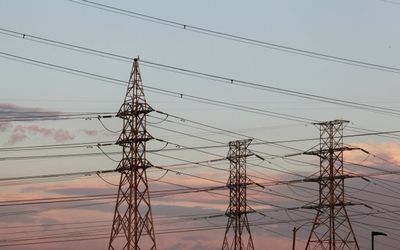Ageing power network needs upgrades
by Siseko Njobeni,
2012-10-07 12:13:39.0
EVERY now and then South Africans get an unwelcome reminder about the poor state of the country’s electricity distribution network. Whenever the state of the electricity distribution infrastructure is discussed, cries of concern are heard, but little gets done about it.
The distribution infrastructure has a R35bn maintenance backlog that keeps on mounting, at the risk of major power problems. The distribution network is a vital cog in the electricity chain because it is closest to the power consumer.
Not long ago, Parliament had public hearings on the restructuring of the industry. Industry experts offered all sorts of advice on how the industry could tackle its problems.
Before the parliamentary hearings, the state of electricity distribution had been discussed in various forums. Four years ago there was a national electricity maintenance summit, which was aptly themed "Towards a sustainable electricity distribution industry".
That was the second maintenance summit. The first one was in 2003.
Lungile Mginqi, senior executive: utilities practice at Accenture S A, says it is only a matter of time before SA experiences distribution network-related power outages. The power distribution problems have remained unresolved because nothing has triggered immediate action.
"It is difficult to put money on something that seems to be working ," Mr Mginqi says.
It might be working now, but, with a mounting backlog, how long is it going to be before the system snaps? Eskom’s network upgrade required R10bn, while the municipal improvements needed R25bn.
"The life span of most components of the distribution network is 50 years and SA’s network is already about 47 years old, with some of the components already older than 50 years," Mr Mginqi says. "A regular distribution system failure is inevitable."
Grid maintenance required R6.5bn a year, but an average of only R3.5bn was actually spent. "With Eskom and municipalities facing financial pressures, there is no funding to purchase new grid equipment or for maintenance of existing assets," Mr Mginqi says. "A new way of thinking is required ."
A "smart" grid would ensure that power distributors are able to deal with system deficiencies and ensure that investments and maintenance decisions are correct, based on in-depth analysis and evaluation of detailed asset-level data. Smart-grid technology would enable distributors to prolong the useful life of existing assets.
It is difficult to look at the ageing distribution infrastructure without looking at the structure of the distribution industry. The fragmented nature of the industry has often been singled out as one of the main contributing factors to the problem.
In a submission to Parliament, Dick Kruger, deputy head for techno-economics at the Chamber of Mines of SA, said the fragmented state of SA’s electricity distribution sector was the reason for the lack of progress in electrification and the different tariffs. The poor quality of supply and the insufficient investment in assets and maintenance compounded the problem.
One of the resolutions of the 2008 electricity summit was that electricity distribution must finance itself. But this was with the proviso that the government should find ways of supporting municipalities to mitigate the effect of social policies such as free basic services.

Picture: THE TIMES
EVERY now and then South Africans get an unwelcome reminder about the poor state of the country’s electricity distribution network. Whenever the state of the electricity distribution infrastructure is discussed, cries of concern are heard, but little gets done about it.
The distribution infrastructure has a R35bn maintenance backlog that keeps on mounting, at the risk of major power problems. The distribution network is a vital cog in the electricity chain because it is closest to the power consumer.
Not long ago, Parliament had public hearings on the restructuring of the industry. Industry experts offered all sorts of advice on how the industry could tackle its problems.
Before the parliamentary hearings, the state of electricity distribution had been discussed in various forums. Four years ago there was a national electricity maintenance summit, which was aptly themed "Towards a sustainable electricity distribution industry".
That was the second maintenance summit. The first one was in 2003.
Lungile Mginqi, senior executive: utilities practice at Accenture S A, says it is only a matter of time before SA experiences distribution network-related power outages. The power distribution problems have remained unresolved because nothing has triggered immediate action.
"It is difficult to put money on something that seems to be working ," Mr Mginqi says.
It might be working now, but, with a mounting backlog, how long is it going to be before the system snaps? Eskom’s network upgrade required R10bn, while the municipal improvements needed R25bn.
"The life span of most components of the distribution network is 50 years and SA’s network is already about 47 years old, with some of the components already older than 50 years," Mr Mginqi says. "A regular distribution system failure is inevitable."
Grid maintenance required R6.5bn a year, but an average of only R3.5bn was actually spent. "With Eskom and municipalities facing financial pressures, there is no funding to purchase new grid equipment or for maintenance of existing assets," Mr Mginqi says. "A new way of thinking is required ."
A "smart" grid would ensure that power distributors are able to deal with system deficiencies and ensure that investments and maintenance decisions are correct, based on in-depth analysis and evaluation of detailed asset-level data. Smart-grid technology would enable distributors to prolong the useful life of existing assets.
It is difficult to look at the ageing distribution infrastructure without looking at the structure of the distribution industry. The fragmented nature of the industry has often been singled out as one of the main contributing factors to the problem.
In a submission to Parliament, Dick Kruger, deputy head for techno-economics at the Chamber of Mines of SA, said the fragmented state of SA’s electricity distribution sector was the reason for the lack of progress in electrification and the different tariffs. The poor quality of supply and the insufficient investment in assets and maintenance compounded the problem.
One of the resolutions of the 2008 electricity summit was that electricity distribution must finance itself. But this was with the proviso that the government should find ways of supporting municipalities to mitigate the effect of social policies such as free basic services.



























Post a comment